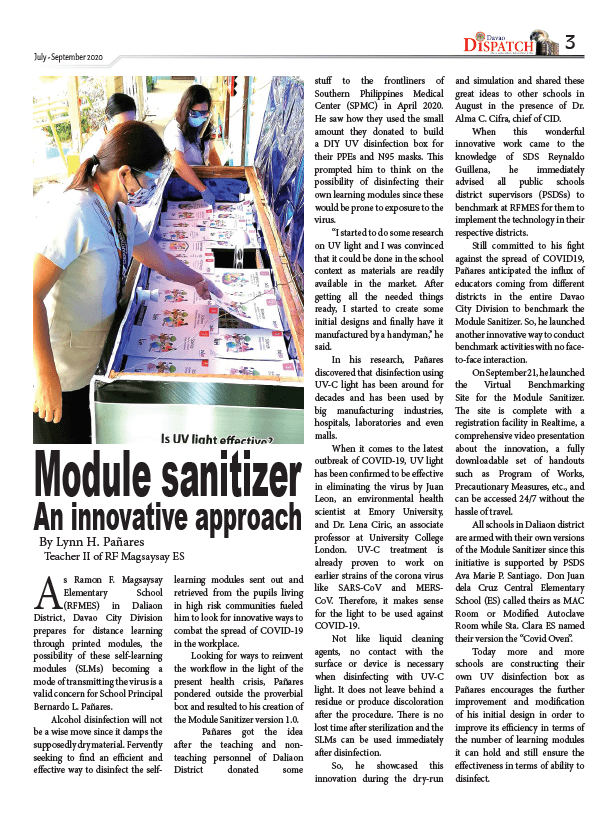As Ramon F. Magsaysay Elementary School (RFMES) in Daliaon District, Davao City Division prepares for distance learning through printed modules, the possibility of these self-learning modules (SLMs) becoming a mode of transmitting the virus is a valid concern for School Principal Bernardo L. Pañares.
Alcohol disinfection will not be a wise move since it damps the supposedly dry material. Fervently seeking to find an efficient and effective way to disinfect the self-learning modules sent out and retrieved from the pupils living in high risk communities fueled him to look for innovative ways to combat the spread of COVID-19 in the workplace.
Looking for ways to reinvent the workflow in the light of the present health crisis, Pañares pondered outside the proverbial box and resulted to his creation of the Module Sanitizer version 1.0.
Pañares got the idea after the teaching and non-teaching personnel of Daliaon District donated some stuff to the frontliners of Southern Philippines Medical Center (SPMC) in April 2020. He saw how they used the small amount they donated to build a DIY UV disinfection box for their PPEs and N95 masks. This prompted him to think on the possibility of disinfecting their own learning modules since these would be prone to exposure to the virus.
“I started to do some research on UV light and I was convinced that it could be done in the school context as materials are readily available in the market. After getting all the needed things ready, I started to create some initial designs and finally have it manufactured by a handyman,” he said.
In his research, Pañares discovered that disinfection using UV-C light has been around for decades and being used by big manufacturing industries, hospitals, laboratories and even malls.
When it comes to the latest outbreak of COVID-19, UV light has been confirmed to be effective in eliminating the virus by Juan Leon, an environmental health scientist at Emory University, and Dr. Lena Ciric, an associate professor at University College London. UV-C treatment is already proven to work on earlier strains of the corona virus like SARS-CoV and MERS-CoV. Therefore, it makes sense for the light to be used against COVID-19.
Not Like liquid cleaning agents, no contact with the surface or device is necessary when disinfecting with UV-C light. It does not leave behind a residue or produce discoloration after the procedure. There is no lost time after sterilization and the SLMs can be used immediately after disinfection.
So, he showcased this innovation during the dry-run and simulation and shared these great ideas to other schools in August in the presence of Dr. Alma C. Cifra, chief of CID.
When this wonderful innovative work came to the knowledge of SDS Reynaldo Guillena, he immediately advised all public schools district supervisors (PSDSs) to benchmark at RFMES for them to implement the technology in their respective districts.
Still committed to his fight against the spread of COVID19, Pañares anticipated the influx of educators coming from different districts in the entire Davao City Division to benchmark the Module Sanitizer. So, he launched another innovative way to conduct benchmark activities with no face-to-face interaction.
On September 21, he launched the Virtual Benchmarking Site for the Module Sanitizer. The site is complete with a registration facility in Realtime, a comprehensive video presentation about the innovation, a fully downloadable set of handouts such as Program of Works, Precautionary Measures, etc., and can be accessed 24/7 without the hassle of travel.
All schools in Daliaon district are armed with their own versions of the Module Sanitizer since this initiative is supported by PSDS Ava Marie P. Santiago. Don Juan dela Cruz Central Elementary School (ES) called theirs as MAC Room or Modified Autoclave Room while Sta. Clara ES named their version the “Covid Oven”.
Today more and more schools are constructing their own UV disinfection box as Pañares encourages the further improvement and modification of his initial design in order to improve its efficiency in terms of the number of learning modules it can hold and still ensure the effectiveness in terms of ability to disinfect. (By Lynn H. Pañares)
This is page 3 of DepEd Davao Dispatch 3rd quarter


